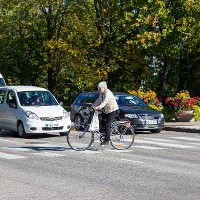23 July 2017 - 27 July 2017
San Francisco, USA
Global aging and health: Bridging science, policy, and practice
Under the conference theme “Global Aging and Health: Bridging Science, Policy, and Practice”, the 21st IAGG World Congress of Gerontology and Geriatrics aims to integrate results from different disciplines, fields, and
model systems, as well as innovative technological
and experimental approaches, into groundbreaking
new ideas that challenge existing paradigms
regarding aging. Two scientists from the Reassessing Ageing from a Population Perspective (Re-Ageing) project at the World Population Program at IIASA will present latest research at this conference.
Sergei Scherbov will present new ways to redefine old age in the session "Gerontology and Geriatrics Education and Research Methods" on 27 July, 10-11.30AM. For many years, Scherbov has conducted research in the field of aging and developed new measures of age and aging together with colleagues. He is currently principal investigator of the Reaging project that, among other things, ascertains the extent to which advanced societies are actually aging in multiple dimensions, including health, cognitive abilities, and longevity.
Orawan Prasitsiriphon will give a presentation under the title "The Associations between Handgrip Strength and its Change on Cardiovascular Incidence", a paper coauthored by Wiraporn Pothisiri, during the session on Geriatric Assessments on 25 July 2017, 6-7.30PM. Prasitsiriphon joined the Re-ageing group in 2016 to work on new measures of ageing using life table measures.
The IAGG 2017 will be held between 23 – 27 July 2017 at the Moscone West and the San Francisco Marriott Marquis, in San Francisco, USA.
For more information to this congress please visit the event website.
Abstracts
The Associations between Handgrip Strength and its Change on Cardiovascular Incidence, Orawan Prasitsiriphon, 25 July 2017, 6-7.30PM
Handgrip strength (HGS) is increasingly becoming a vital factor in physical capability. The last decade has seen a renewed importance in the association between HGS and diabetes, hypertension, and cardiovascular mortality rather than disability and mortality. As far as I known it is not yet known whether the HGS and its change associated with cardiovascular incidence among older adults in European countries.
Data are drawn from the first four waves of the Survey of Health, Ageing and Retirement in Europe (SHARE) with information on HGS, health and demographic characteristics from 7,232 participants aged 50-79 across 10 European countries. HGS was transformed as the low HGS (LGS), the fastest decline in HGS (FDGS), and the combination of the LGS and the FDGS (CBGS). Logistic regression models adjusted for the potential confounders showed that the FDGS and the CBGS were significantly correlated with cardiovascular incidence. However, the LGS as the lowest quintile HGS at baseline Wave was not significantly different from the normal HGS (NGS) on cardiovascular incidence. Both sexes with FDGS would have higher odds of experiencing cardiovascular development (all, P<0.02).
In the CBGS, men with NGS&FDGS (P=0.008) and women with LGS&FDGS (P=0.000) were likely to have higher odds of having cardiovascular diseases. In conclusion, the decline in HGS and the CBGS should be considered as an indicator of incidence of cardiovascular disease among older adults. The further studies on the current topic are
therefore suggested in order to establish in clinical setting.
New Ways to Redefine old Age, Sergei Scherbov, 27 July, 10-11.30AM
In many regions of the world, life expectancy has increased significantly in recent decades and continues to increase. As people live longer, they also stay healthier for longer. But most studies of population aging focus on only one characteristic of people: their chronological age. The implicit assumption is that other characteristics relevant to population aging do not change over time and place. For example, the Old Age
Dependency Ratio (OADR) categorizes people as “old” at age 65, regardless of whether those people were living 50 years ago or likely to be living 50 years in the future. But clearly this is not true. 65-year-olds today generally have higher remaining life expediencies and are healthier than their counterparts in previous generations—which is reflected, in many countries, in rising ages of eligibility for public pensions. Many important characteristics of people vary with age, but age-specific characteristics also vary over time and differ from place to place. Focusing on only one aspect of the changes entailed in population aging but not on all the others provides a limited picture of the process, one that is often not appropriate for either scientific study or policy analysis.
The presentation will be devoted to the new ways of measuring aging that more accurately represent the real world. It will be shown that once more adequate measures of aging are used past aging looks very different and in countries with high life expectancy almost no aging was observed. Future aging trends look also much less gloomy when new indicators of aging are used compared to a traditional approach.
Recently developed characteristic approach for a study of population aging will be also introduced and used in evaluating differences in aging across space and time. The main idea of the approach is the conversion of different characteristics that reflect people’s physical, cognitive or health conditions to a single metric. The hallmark of the approach is the consistent use of changing characteristic schedules together with changing age structures, regardless of the exact way in which the two are combined.
Literature
- Sanderson WC, & Scherbov S. (2014) Measuring the speed of aging across population subgroups. PLoS ONE, 9(5), e96289.
- Sanderson WC, & Scherbov S. (2013). The characteristics approach to the measurement of population aging, Population and Development Review, 39(4), 673–685.
- Sanderson WC, & Scherbov S. (2010). Remeasuring aging. Science, 329(5997), 1287–1288.
- Sanderson, WC, & Scherbov S. (2005). Average remaining lifetimes can increase as human populations age. Nature, 435(7043), 811–813.

Re-Aging Project
PUBLICATIONS
Demographic Data Sheets


